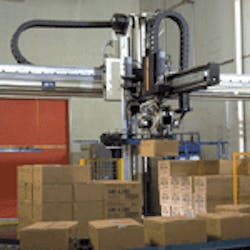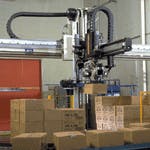Technology Trends: Vision system coordinates depalletizing robot operations
To eliminate worker injury and stress, the General Mills Cereal Plant (Cedar Rapids, IA) uses a depalletizing robot to unload 30-lb boxes of foodstuffs. In the past, a four-axis motion-control system from CTC Parker Automation (Milford, OH) was used to drive the company's CTC 2600 robot to preprogrammed geometric positions.
"This [method] required extensive programming and had a limited capability of dealing with variations in pallet geometry," says Terry Aukes, packaging systems engineer at General Mills. "It was not user friendly, and there were only a handful of people here who could do anything with it."
To overcome these problems, Aukes hired designer Ken Dotzenroth of Roth Greaves and Associates (Minneapolis, MN) to incorporate machine vision into the robotic system. In his vision-system approach, Dotzenroth uses two Series 600 SmartImage Sensors from DVT (Norcross, GA) mounted approximately 16 feet above the floor directly over each pallet-unloading position. "Using this vision system we can simplify setup, learn on the fly, and eliminate the need to create detailed ladder logic," says Aukes.
Using two cameras, the vision system generates Cartesian coordinates for robot motion and automatically communicates this information to the robot servo controller," says Dotzenroth. "The systems are connected to the CTC robot controller via an RS-232 connection, and, on start-up, the robot goes through a homing process in preparation for unloading pallets," he adds.
PHOTO. In the factory, the robotic depalletizer uses dual pallets to carry various boxes of food ingredients to cereal-manufacturing lines. Mounted to a U-bracket on the ceiling above the pallet unloading position are two Series 600 SmartImage sensors that add vision capabilities to the robotic system.
During system operation, pallets are initially loaded into position below the cameras. The CTC controller then triggers the Series 600 sensors to capture an image of the pallets. The sensors use blob-analysis tools in Windows-based software, FrameWork, to calculate the number of boxes and locate their centers. The center-position data are then transmitted to the robot controller in serial strings via FrameWork's DataLink tool. These serial strings are programmed in FrameWork to transform the coordinate data to the syntax of the CTC robot controller. The-vision-based robot system then sequentially unloads each box of ingredients on the pallet.
Future plans include taking advantage of the Series 600 sensor-Ethernet connectivity. "We plan to add an Ethernet hub that will tie in to the plant network so we can monitor the system over the network," says Aukes.

